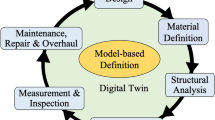Abstract
One of the fundamental axioms of concurrent engineering is that undertaking functional design without foreseeing the manufacturing process leads to production delays and increased costs. This widely accepted concurrent engineering principle is given a formal basis by development of a mathematical model for the conversion of a feature-based design representation to a manufacturing representation. Within the domain of thin-walled components, it is shown that the conversion to tooling cost representations can result in a discontinuous function when the sets of design and manufacturing representations have been formulated as topological spaces. This discontinuity formally reflects the folklore that a small design change can significantly increase product cost. The mathematical sophistication required within this model is suggestive of why manufacturability evaluations can be quite difficult.
Similar content being viewed by others
References
Chuang, S.-H., and Henderson, M.R. (1991), “Compound Feature Recognition by Web Grammar Parsing,”Research in Engineering Design, 2(3):147–158.
Joshi, S., and Chang, T. (1988), “Graph Based Heuristics for Recognition of Machines Features from a 3D Model,”Computer-Aided Design, 20(2):58–66.
Karinthi, R. and Nau, D. (1990), “Handling Feature Interactions Using a Feature Algebra,” Proceedings National Conference on Artificial Intellience, AAAI-90.
Munkres, J.R. (1975),Topology: A First Course, Prentice-Hall.
Peters, T.J. (1992), “Encoding Mechanical Design Features for Recognition via Neural Nets,” to appear inResearch in Engineering Design.
Pinilla, J.M., Finger, S., and Prinz, F. (1989), “Shape Feature Description and Recognition Using an Augmented Topology Graph Grammar,” NSF Engineering Design Research Conference, Amherst, MA.
Poli, C., Escudero, J., and Fernandez, F. (1988), “How Part Design Affects Injection Molding Tool Costs,”Machine Design, Nov. 24.
Rosen, D.W., Dixon, J.R., and Dong, X. (1991), “A Methodology for Conversions of Feature-Based Representations,” Proceedings of ASME Design Theory and Methodology Conference.
Rosen, D.W. (1992), “A Feature-Based Representation to Support the Design Process and the Manufacturability Evaluation of Mechanical Components,” PhD thesis, University of Massachusetts, Amherst.
Shah, J.J. (1989), “Feature Transformations between Application-Specific Feature Spaces,”Computer-Aided Engineering Journal, 5(6):247–255.
Taura, T. and Yoshikawa, H. (1991), “A Metric Space for Intelligent CAD,” Proceedings of IFIP WG 5.2, Columbus, OH.
Yoshikawa, H. (1982), “General Design Theory and a CAD System,” Man-Machine Communications in CAD/CAM, Proceedings of IFIP WG 5.2, North-Holland.
Author information
Authors and Affiliations
Rights and permissions
About this article
Cite this article
Rosen, D.W., Peters, T.J. Topological properties that model feature-based representation conversions within concurrent engineering. Research in Engineering Design 4, 147–158 (1992). https://doi.org/10.1007/BF01607943
Issue Date:
DOI: https://doi.org/10.1007/BF01607943




